Dosa Recipe & Dosa Batter Recipe
Dosa is a traditional and ever popular South Indian breakfast dish made from a fermented rice and urad dal (black gram) batter, spread thin on a hot griddle, creating a golden, savory, crispy crepe typically served with Coconut Chutney and Sambar for a flavorful and wholesome meal. With just a handful of ingredients learn to make the classic Dosa recipe with my easy video and step-by-step photos. I also cover making your own dosa batter in a blender or mixer-grinder, tips on fermentation and cooking dosa to help you make the best dosa – crispy, soft and so good.
About Dosa Recipe
Dosa also called as Dosai (in Tamil language) is a famous and popular South Indian breakfast or snack in India as well in the rest of the world. Dosa are basically crispy or soft crepes made with ground and fermented lentil and rice batter.
To make the batter, first the lentils and rice are soaked in water for 4 to 5 hours. They are then ground separately to a fine consistency.
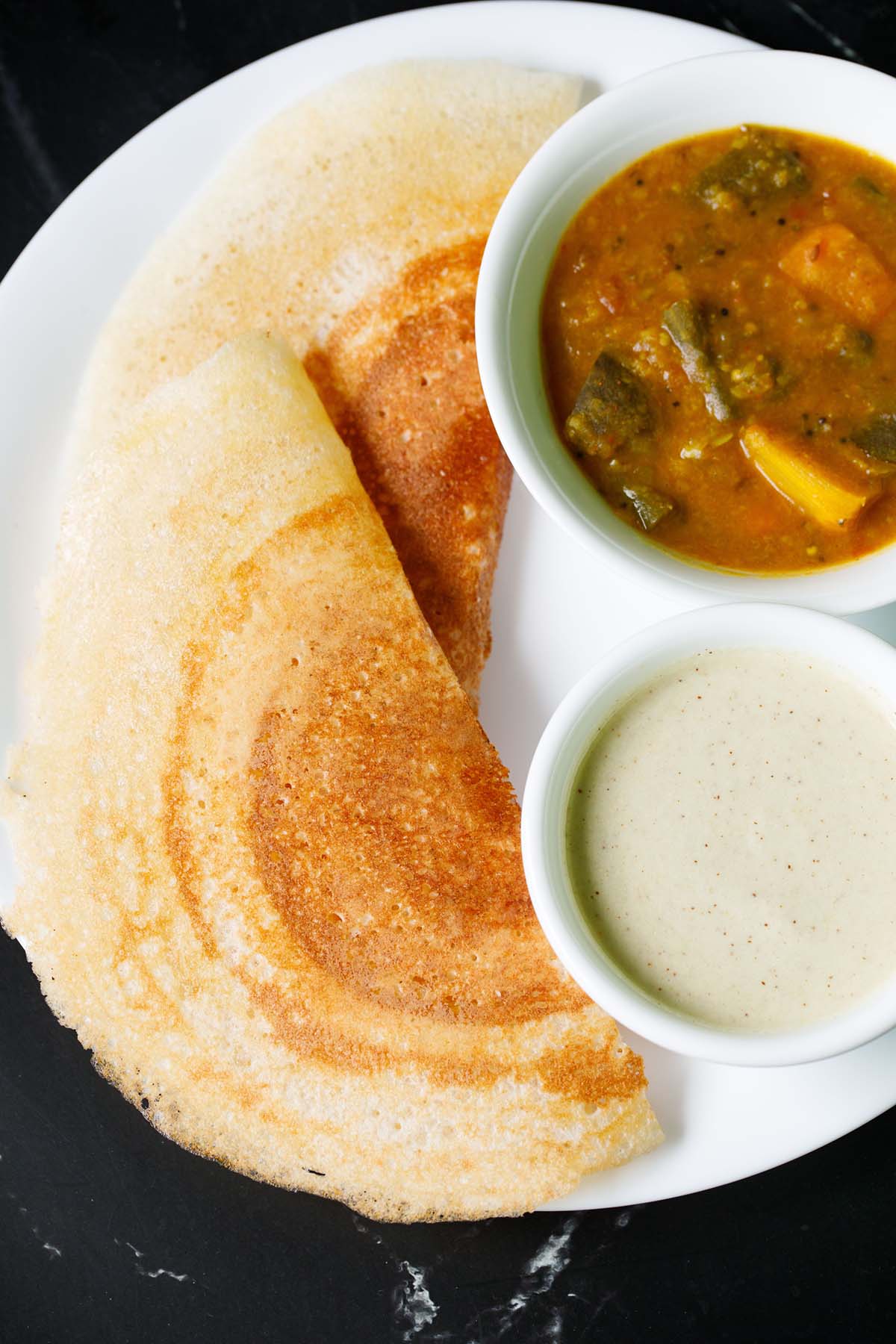
Then both the lentil batter and the rice batter are mixed with salt in a wide bowl or pan. This batter is then allowed to ferment overnight or for 8 to 9 hours.
After the batter is fermented, it increases in volume, has a pleasant fermented aroma and a slightly sour taste. A well-fermented batter makes the best dosa. You will also see many tiny air-pockets in the batter.
Making the batter and then fermenting it is such a joy that I always look forward to making fermented foods like dosa and idli.
The fermented batter is poured on a seasoned cast-iron pan or skillet (tawa) and spread like a pancake and cooked till crispy and golden with a drizzle of oil or ghee.
Lentils To Be Used
The lentils used to make dosa batter are husked and split Black Gram. These are also known as Urad Dal in Hindi. The other English names of urad dal are Black Matpe Bean, Mungo Bean and Vigna Mungo (botanical name).
Urad dal is available whole as well as split. To make dosa, you can use either the husked whole urad dal or the husked and split urad dal. Both these types of urad dal have an off-white color. The black husks on them have been removed.
For a crispy dosa adding 2 to 3 tablespoons chana dal (husked bengal gram) works wonderfully. Some variations also include adding both 2 tablespoons of chana dal and 2 tablespoons of tur dal (pigeon pea lentils).
You can also add about ¼ cup moong lentils to the batter. Though urad dal forms the bulk of the lentils, but for a mixture of various proteins, consider adding 2 to 3 tablespoons of lentils like chana dal, tur dal, moong dal or masoor dal (red lentils).
Variety Of Rice To Use
The rice used to make dosa batter can be short or medium-grained white rice or parboiled idli rice.
A basic dosa recipe will just have rice, urad dal and salt. The proportions for making dosa vary and by changing the proportions you can alter the texture by having a soft thick dosa to a thin dosa or a crispy dosa.
The addition of some more ingredients like flattened rice (parched rice or poha), different types of lentils also changes the texture. The color also varies from being an opaque white to pale golden or reddish or golden.
Many readers ask me what is parboiled rice and idli rice. So I will mention it.
- Parboiled Rice is rice which is partially cooked in their husks. Later they are dried and milled. They are also known as converted rice. Parboiled rice is used for making steamed rice, savory rice porridge (which we call kanji) and snacks too.
- Idli Rice is a type of parboiled rice and is specifically meant to make idli or dosa. But I have also cooked them and they taste great with sambar or any other curry or stew. Note that you can use also make the batter with only regular white rice. I personally prefer the Indian varieties of sona masuri or parmal rice.
- Regular Rice is polished white rice where its husk, bran and germ have been removed.
So we can sum up that there are many varieties of dosa that can be made with textures ranging from crisp to soft to fluffy to light.
These varying textures are due to the proportion of the rice, urad dal and other ingredients used in the dosa batter recipe. That said, dosa can also be made with brown rice or hand-pounded rice.
About This Recipe
Plain dosa is also called as Sada dosa. The word “Sada’ means plain or simple. Truly so as this humble Sada dosa is served without the potato stuffing (potato masala). So you relish the dosa with just the coconut chutney and sambar.
The Sada Dosa recipe I am sharing here is what I generally make. The dosa batter recipe uses 3:0.75 proportions for rice and lentils respectively. Apart from the rice, I also add some flattened rice (poha) for softness and fenugreek seeds (to help in fermentation).
Adding flattened rice adds a touch of softness to the dosa. So this dosa recipe makes for crisp as well as soft textured dosa. This is how we prefer them at home.
In this recipe, I have used a mix of idli rice and regular rice. But you can also just use idli rice or regular rice.
Both sona masuri and parmal rice also work well in the recipe. In the video, I have shown making the dosa with idli rice only.
The dosa batter that is made with this recipe will finish up the whole batter in a day for a family of 3 to 4.
In summers, I usually make a lesser proportion as the batter tends to get sour quickly. While in winters, I double the proportions.
I have also ground the rice and lentils together as this much quantity my mixer-grinder can accommodate without grinding them separately. But if you increase the proportions, then do grind the lentils and rice separately.
This is a foolproof tried and tested dosa recipe and you can easily scale the recipe. If doubling or tripling this dosa recipe, then soak urad dal + methi seeds in a separate bowl.
Grind urad dal and methi seeds separately. Grind rice separately. Then mix both the batters in a large bowl or pan.
This dosa batter is a 2 in 1 batter as it can be used to make Idli, Uttapam and Paniyaram. The best part of this dosa batter is that you can make the dosa thin, crispy as well as thick and soft.
It is up to you. I make both. With the same batter, you can make a variety of dosa.
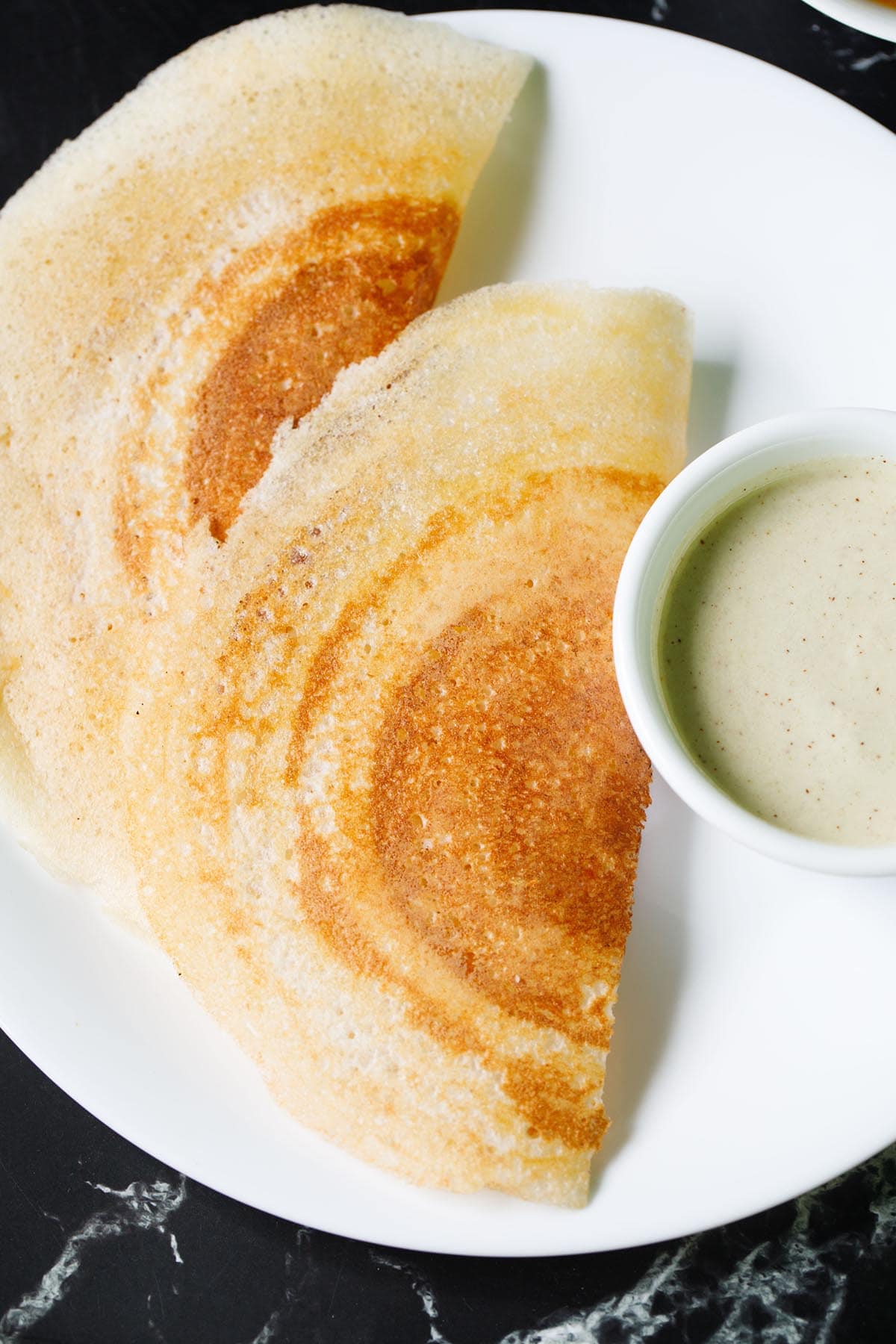
How to make Dosa
Soaking the lentils, rice, making the batter, fermenting the batter calls for time, planning and some prep work. So for your ease of understanding, I have divided this step by step guide into 4 main parts:
- Soaking rice and lentils
- Making dosa batter in a blender or mixer-grinder
- Fermenting dosa batter
- Making dosa
Soak Rice & Lentils
1. In a bowl take ½ cup idli rice or parboiled rice along with ½ cup regular rice. Instead of adding regular rice, you can also make the dosa with a total of 1 cup idli rice as I have shown in the video.
Kindly note that the video has the recipe ingredients doubled in proportion.
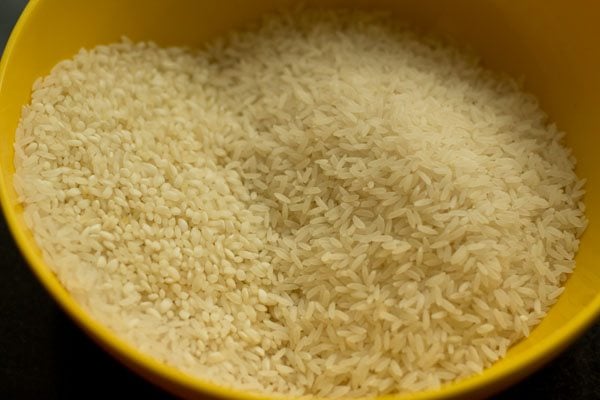
2. To the same bowl, add ¼ cup urad dal and ⅛ teaspoon fenugreek seeds (methi).
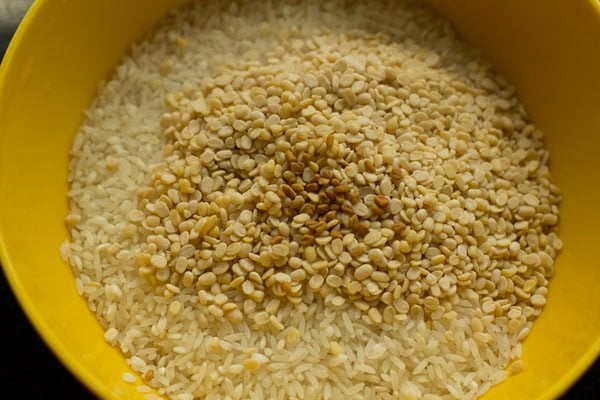
3. Rinse the rice, lentils and methi seeds together a couple of times and keep them aside.
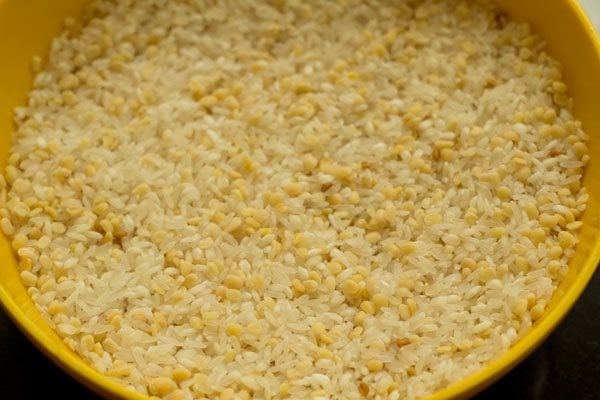
4. In a separate bowl, take 2 tablespoons of thick poha (flattened rice or parched rice).
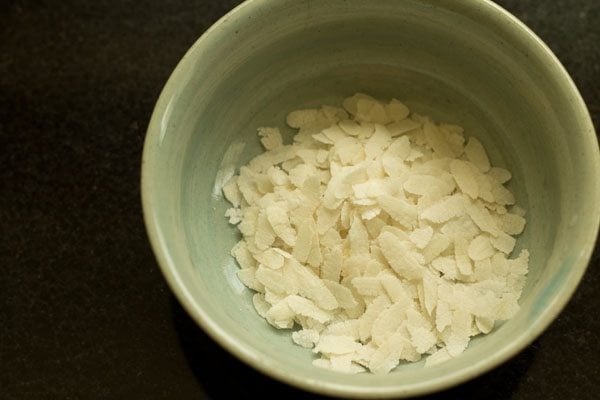
5. Rinse poha once or twice in water and then add to the bowl containing the rinsed rice+lentils+methi seeds.
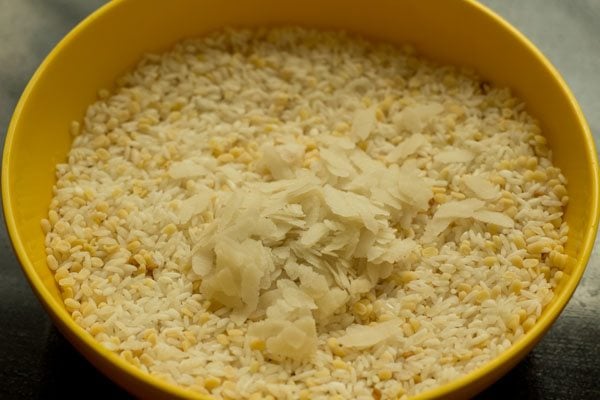
6. Add 1.5 cups of water and mix. Cover with a lid and soak everything for 4 to 5 hours.
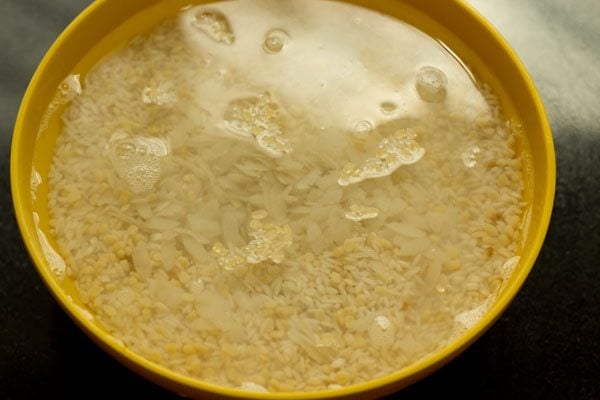
Make Dosa Batter
7. Drain all the water and add the soaked ingredients to a mixer grinder or a blender.
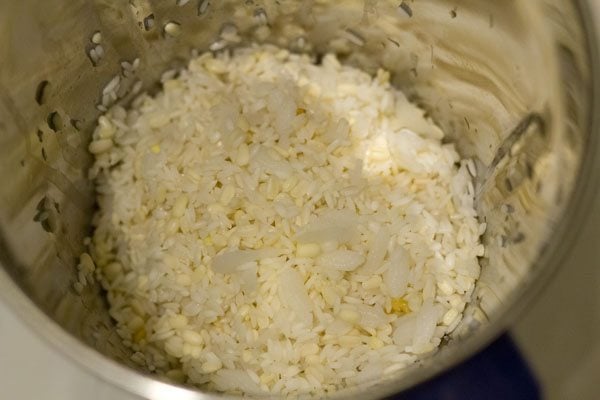
8. Add ⅔ to ¾ cup water and grind or blend till you get a fine grainy consistency of rice in the batter. A smooth consistency of the batter is also fine.
If the mixer gets heated up, then stop and wait for some minutes. When the mixer cools down, grind again.
Depending on the jar capacity, you can grind everything once or in two batches. I ground in two batches and added a total of ¾ cup water.
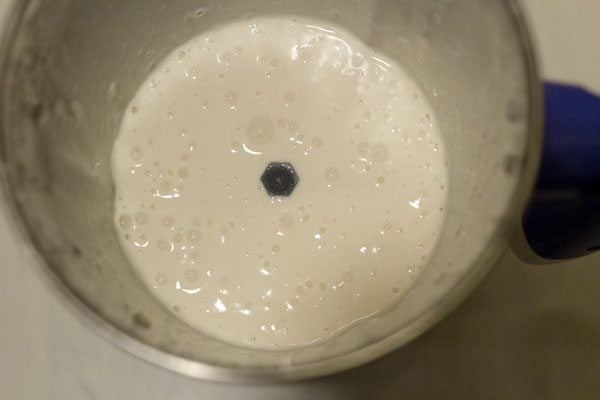
9. Now take the batter in a large bowl or pan. In case the dosa batter becomes thin, then add a few tablespoons of rice flour to thicken it. Mix the rice flour very well in the batter.
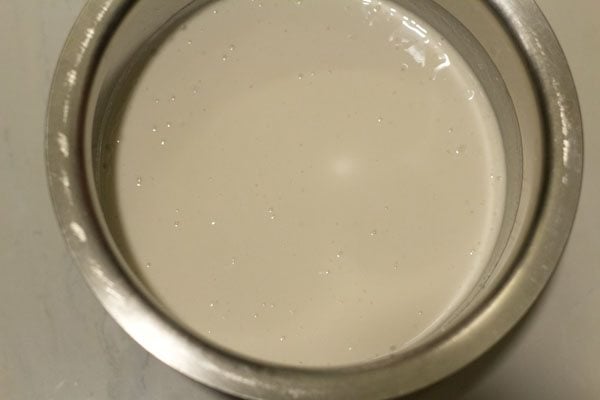
10. Add ½ teaspoon of edible rock salt. Mix very well. Instead of rock salt, you can use non-iodized salt or sea salt crystals or Himalayan pink salt.
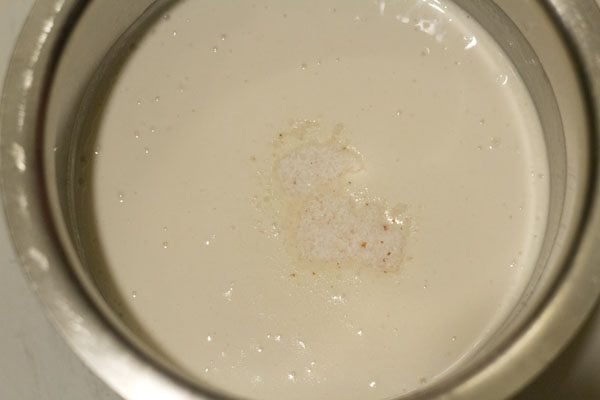
Ferment Dosa Batter
11. Cover and allow to ferment for 8 to 9 hours or more. The time of fermentation will vary depending on the temperature conditions, climate and altitude.
In winters, the time of fermentation can go up to 14 to 24 hours. If you live in a cold city or high altitude then I highly recommend fermenting the batter in an Instant pot if you have one.
I have listed below more fermentation tips and suggestions including fermenting dosa batter in an Instant pot. So do read these handy and helpful tips.
In the below photo, you see the dosa batter after 11 hours of fermentation. A proper fermentation will double or triple up the volume of the batter with a light sour aroma.
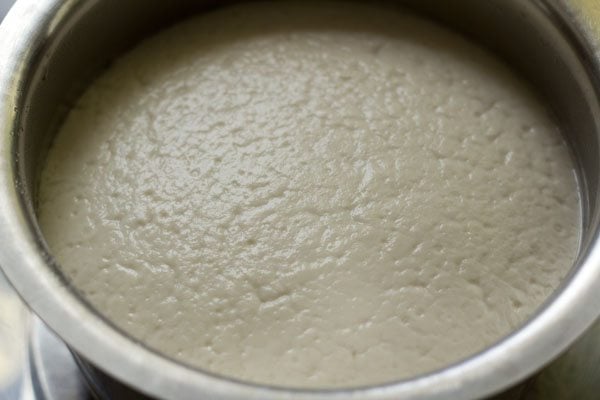
12. Now lightly stir the batter, before you begin to make dosa. You will also see many tiny air pockets in the batter. As you see in the below photo, the batter is very well fermented.
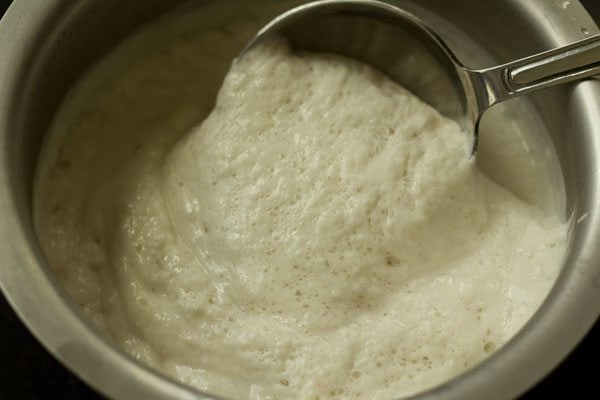
Make Dosa
1. Heat a cast iron pan. When the pan becomes hot, spread ¼ to ½ teaspoon oil all over the pan with a spoon or with a thick paper towel dipped in oil. For a richer taste, you can cook the dosa with ghee or butter.
Note that the oil should be spread evenly or else it becomes difficult to spread the batter. If the pan is well seasoned you don’t need to spread oil. I suggest keeping a separate skillet or tawa to make only dosa.
Do keep the heat on low to low-medium flame, so that you are easily able to spread the batter. If the pan base is very thick, then keep the flame to medium.
For a low-fat option, just make the dosa without any oil. But make sure that your pan is well seasoned. Otherwise the dosa will stick to the pan.
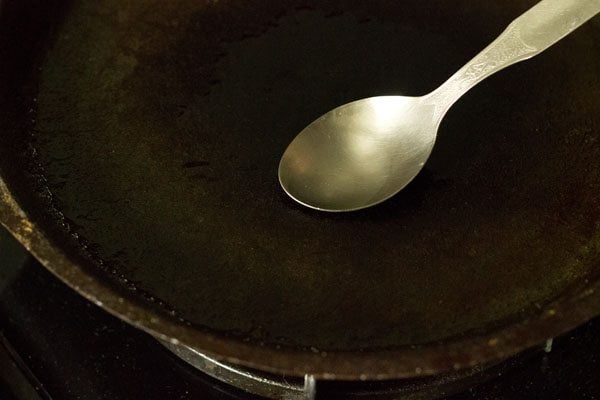
2. Now take a ladle full of the dosa batter or about ¼ cup of the batter. Pour the batter and gently spread the batter starting from the center and moving outwards. In the below photo you will see a well-spread dosa batter.
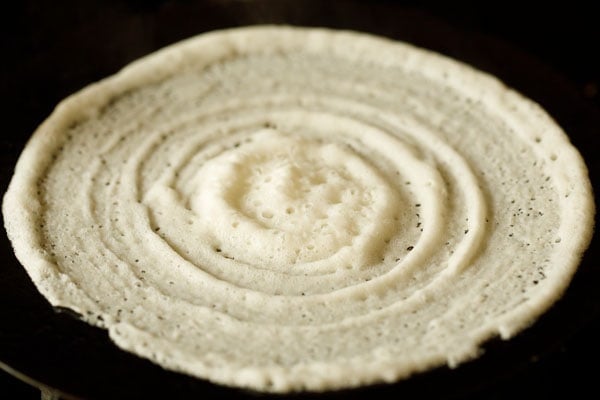
3. Cook the dosa on low to medium heat. Do regulate the heat as per the pan size and thickness. You can even cover the dosa with a lid and let it get cooked from the bottom as I do.
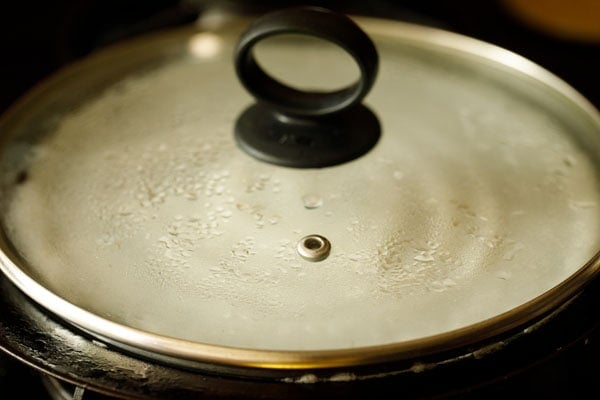
4. Cook till the base is nicely golden and crisp. The base will leave the pan and the edges separate when it gets cooked.
When you see the batter on the top cooked well and the base has become golden, then sprinkle ¼ to ½ teaspoon oil on the edges and center. With the spoon spread the oil on the dosa.
If you prefer, you can flip the dosa and cook the top side for a minute.
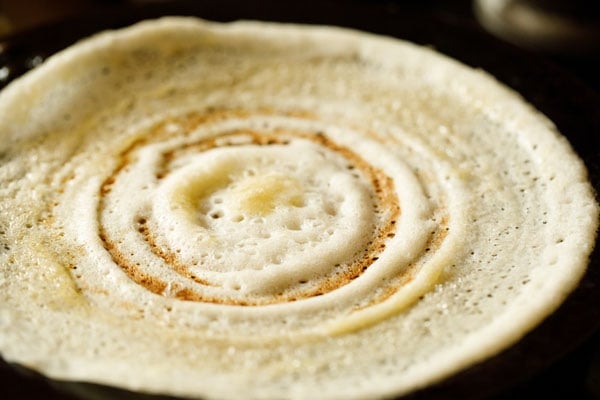
6. When the dosa has nicely browned from the bottom and the surface looks well cooked, soft without any specks of undercooked batter, then fold with a spatula and lift it from the pan.
Make the remaining batches of dosa this way. Keep the leftover batter in the refrigerator for 1 to 2 days or you can freeze it for a week.
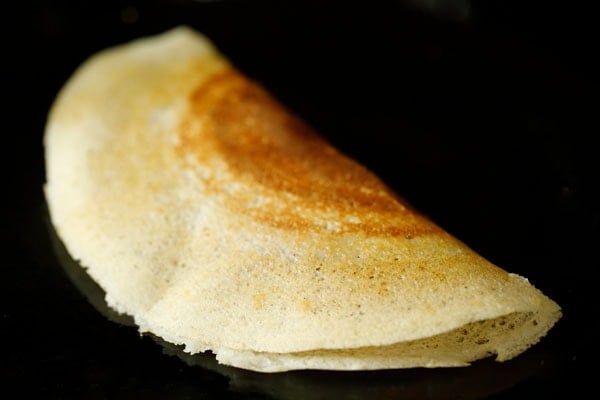
9. Serve Dosa hot with coconut chutney, potato masala and sambar. It is best to serve these crispy dosa hot.
If you want to serve it with potato curry (potato masala), then do check my recipe of Masala Dosa. You can also check this recipe of Poori Masala which makes for a tasty potato curry.
If you have any batter remaining, then store in an air-tight container for 2 to 3 days in the fridge. You can also freeze the batter for a week. Before making dosa, thaw the batter at room temperature.
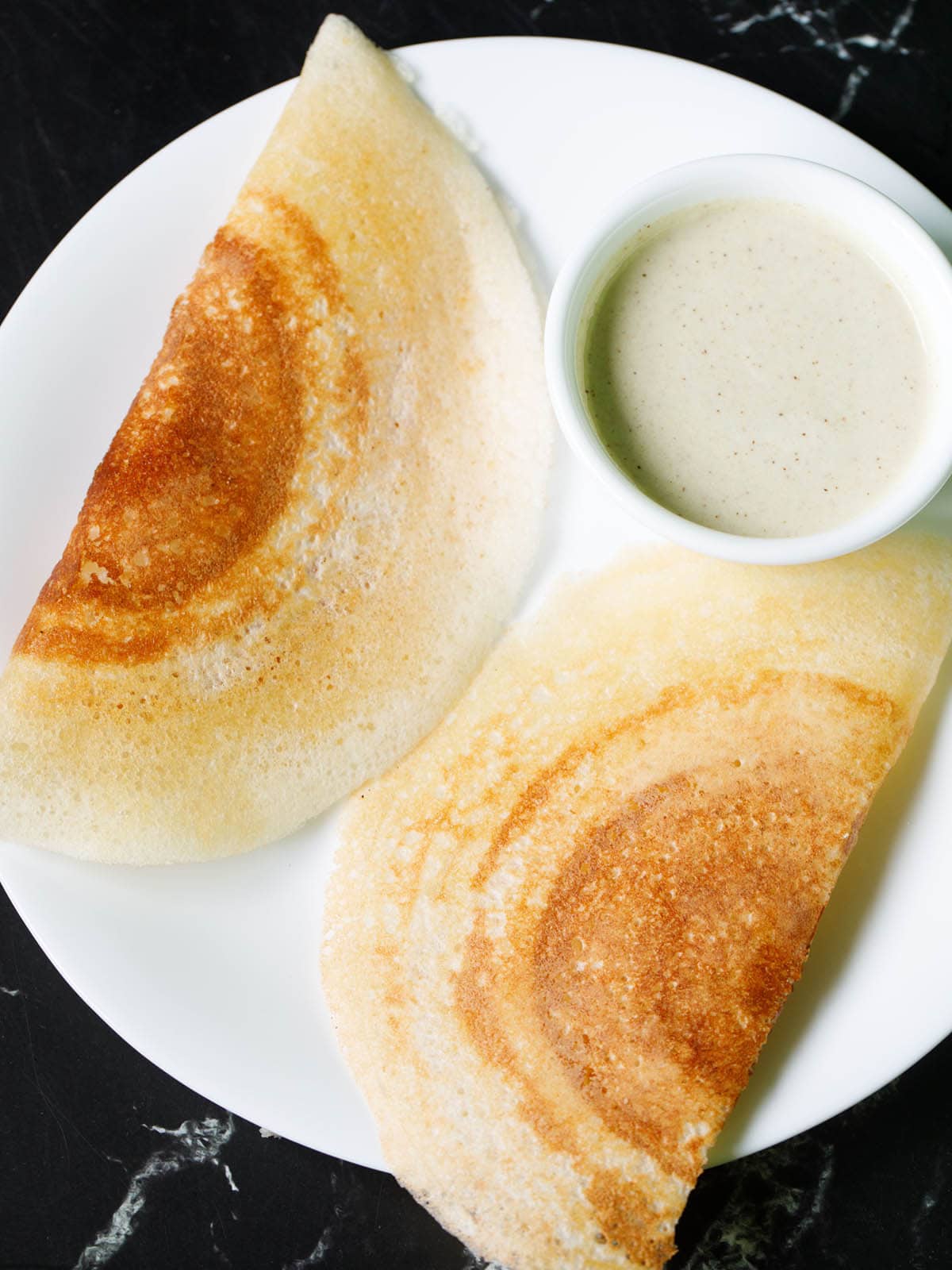
Tips & Tricks For Dosa Batter Fermentation
- Temperature: Do take into account the temperature of the city in which you live, as temperature is one of the most important factors for proper fermentation.
- Urad Dal: Make sure that the urad dal you use is fresh and within its expiry date.
- Salt: Use non iodized salt. I use edible rock salt. You can even use pink salt or sea salt.
- Rice: You can make this dosa recipe with only parboiled rice recipe (idli rice) or regular white rice or with a combination of idli rice and regular rice.
- Fermenting Batter in cooler climates:
- Keep the batter bowl in a warm place – e.g near a heater or in a warm place in your kitchen.
- You can also preheat your oven at a low temperature (80 to 90 degrees Celsius) for about 10 minutes. Then switch off the oven and keep the batter bowl inside – I use this method when it becomes very cold outside.
- Alternatively, if your oven has lights, then keep the lights on and place the batter inside.
- Addition a bit of sugar does help in fermenting the batter – I use this method at times in the winters here.
- Skip adding salt to the batter as salt retards the fermentation process. Sometimes I add both salt and sugar together. I always use edible rock salt in the idli batter.
- Keep the batter for a longer time to ferment, like 14 to 24 hours.
- Do remember that even if you do not see the batter doubled or tripled, you should see tiny bubbles in the batter. You should also get the typical faint sour fermented aroma from the batter.
- Adding ¼ to ½ teaspoon of instant yeast (dissolved in 2 to 3 teaspoons water) 30 to 45 minutes before you make the dosa also helps. But do this method when the batter has not fermented well. The downside of this method is that you have to use all the batter at once. If you refrigerate then the batter gets too yeasty.
- You can also add ¼ to ½ teaspoon baking soda and then ferment the batter in cold seasons.
How to ferment dosa batter in the Instant Pot
For cooler or colder climates or seasons, the Instant Pot comes in very handy to fermenting the batter. For fermenting all my idli and dosa batter during the cooler seasons, I have been using the Instant Pot.
After you have made the batter, either place it in a bowl or pan or pour the batter in the steel insert of your IP. I usually place the bowl of dosa batter on a small trivet inside the steel insert.
Place the instant pot glass lid. Press the yogurt button and choose the low mode setting of the yogurt option. Do not choose the normal mode as it will cook your batter very slowly and you don’t want that.
Set the time to 8 to 12 hours. The time to ferment will depend on the the climate, season, temperature and altitude of the place you are living in. In warmer or hotter season, the batter ferments in the Instant Pot in about 7 to 8 hours and in winter it takes 10 to 12 hours.
How to make dosa batter in a wet grinder
According to me, both the a wet grinder and a blender or mixer-grinder work well. For large batters, a table-top wet grinder (stone grinder) does a fabulous job.
A mixie or mixer-grinder is good for small to medium quantities of batter. I have used both wet grinder as well as mixer-grinder.
For large quantities of batters, I do use a wet grinder, but lately I use mixer-grinder, as the one I have is too large and lifting and washing it is one big task.
So I use my Preethi mixer-grinder (Blue Leaf platinum MG 139 750-watt) and it gives me good results every time. The batter does not become hot or warm. Vitamix is also a great blender to whip up a dosa batter in minutes.
If you plan to grind the batter in a table top wet grinder, then double or triple the proportions of the ingredients for this recipe. For a wet grinder, you will need to add some more water while grinding. The urad dal batter really becomes fluffy and light like whipped cream in a wet stone grinder.
I have listed the proportion of water that you need to add while grinding the ingredients in a table-top wet grinder.
- For ½ cup of urad dal, add 1.5 cups water
- For 2 cups of rice, add 2.5 cups water
Add the water in parts when grinding urad dal together with the fenugreek seeds, so that it becomes nicely fluffy and increases in volume.
After you have ground the urad dal, you don’t need to remove it. Just let the batter remain in the wet grinder. Add the rice and continue to grind.
How to season a skillet or tawa for making any dosa variety
Another point to be considered is the use of a seasoned tawa or pan. If using a cast iron tawa, it has to be well seasoned. By seasoning I mean the pan is used often to make dosa. If you make roti on a tawa and use the same tawa, then there is a possibility that the dosa will stick.
To season a pan, heat it on a medium to high heat. Smear the pan with oil all over. Switch off the heat and keep it aside for 2 to 3 days.
Before making dosa, heat the pan. Remove the residue oil with a kitchen paper tissue. Again spread oil all over. Heat for some seconds and then again remove the oil. Again spread oil and use the pan for making dosa.
If the pan is not seasoned, the dosa will stick on it. Cast iron pans are the best to make dosa. You can even make it in a non-stick pan, but do try once making in a cast iron pan and you will notice the difference.
Step by Step Photo Guide Above
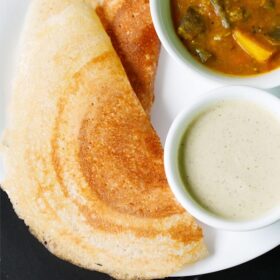
Dosa Recipe & Dosa Batter Recipe
Ingredients
- ½ cup idli rice or parboiled rice or regular rice – 100 grams
- ½ cup regular rice – 100 grams
- ¼ cup urad dal – 50 grams (husked whole or split black gram)
- ⅛ teaspoon fenugreek seeds or 2 pinches (methi seeds or methi dana)
- 2 tablespoons thick poha (flattened rice)
- 1.5 cups water – for soaking both rice and lentils
- ¾ cup water – for grinding, do add water as required
- ½ teaspoon rock salt – edible and food grade or non-iodized salt or sea salt crystals or Himalayan pink salt
- oil as required
Instructions
Soaking Lentils and Rice
- In a bowl take the idli rice or parboiled rice along with the regular white rice.Instead of adding regular rice, you can also make the dosa with a total of 1 cup idli rice as I have shown in the video. The video has the recipe ingredients doubled in proportion.
- To the same bowl, add urad dal and fenugreek seeds.
- Rinse the rice, lentils and methi seeds together a couple of times and keep aside.
- In a separate bowl, take the flattened rice.
- Rinse it once or twice in water and then add rinsed flattened rice to the bowl containing the rinsed rice+lentils+methi seeds.
- Pour 1.5 cups water. Mix. Cover with a lid and soak everything for 5 to 6 hours.
Making dosa batter
- Drain all the water and add the soaked ingredients in a wet grinder jar.
- Add ⅔ to ¾ cup water and grind till you get a fine grainy consistency of rice in the batter. A smooth consistency of batter is also fine.
- If the mixer gets heated up, then stop and wait for some minutes. When the mixer cools down, grind again. Depending on the jar capacity, you can grind everything once or in two batches. I ground in two batches and added overall ¾ cup water.
- Now take the batter in a large bowl or pan.
- Add ½ tsp rock salt. Mix very well. Cover and allow to ferment for 8 to 9 hours or more. Time of fermentation will vary depending on the temperature conditions.
- A proper fermentation will double or triple up the volume of the batter and you will see tiny air pockets in the batter with a light sour aroma.
- Now lightly stir the batter, before you begin to make dosa.
Making Dosa
- Heat a cast iron pan. When the pan becomes hot, spread ¼ to ½ teaspoon oil all over the pan. Do keep the heat on low to low-medium heat, so that you are easily able to spread the batter. If the pan base is very thick, then keep the flame to medium.
- Do not spread oil if you are using a non stick pan, as you won’t be able to spread the batter.
- Now take a ladle full of the batter. Pour the dosa batter and gently spread the batter starting from the center and moving outwards.
- Cover it with a lid and cook the dosa on a low to medium heat. Do regulate the flame as per the pan size and thickness.
- When you see the batter on the top has cooked well and the bottom has become crisp and golden, then sprinkle ¼ to ½ teaspoon oil on the edges and center.
- With the spoon spread the oil on the dosa.
- Cook till the base is nicely golden and crisp. The base will leave the pan and the sides will also get separated when it gets cooked.
- Fold and serve sada dosa hot. Make all dosai this way.
- Serve these crisp plain dosa with sambar or potato masala or coconut chutney.
Video
Notes
Recipe Notes:
- Scaling: You can easily halve, double or triple this sada dosa recipe. If doubling or tripling the dosa recipe, then soak urad dal + methi seeds in a separate bowl. Grind urad dal and methi seeds separately. Grind rice separately. Then mix both the batters in a large bowl or pan. Grind soaked rice in two to three batches.
- Rice: Instead of adding regular rice, you can also make the dosa with total of 1 cup idli rice as I have shown in the video. The video has the recipe ingredients doubled in proportion.
- Temperature: Do take into account the temperature of the city in which you live, as temperature is one of the important factors for proper fermentation.
- Urad Dal: Make sure that the urad dal you use is fresh and within its expiry date.
- Salt: Use non-iodized salt. I use rock salt. You can even use pink salt.
Tips for dosa batter fermentation in cooler climates:
- Keep the batter bowl in a warm place – e.g near a heater or in a warm place in your kitchen.
- You can also preheat your oven at a low temperature (80 to 90 degrees Celsius) for about 10 minutes. Then switch off the oven and keep the batter bowl inside – I use this method when it becomes very cold outside.
- Alternatively, if your oven has lights, then keep the lights on and place the batter inside.
- Addition a bit of sugar does help in fermenting the batter – I use this method at times in the winters here.
- Skip adding salt to the batter as salt retards the fermentation process. Sometimes I add both salt and sugar together. I always use rock salt in the idli batter.
- Keep the batter for a longer time to ferment, like 14 to 24 hours.
- Do remember that even if you do not see the batter doubled or tripled, you should see tiny bubbles in the batter. You should also get the typical faint sour fermented aroma from the batter.
- Adding ¼ to ½ tsp of instant yeast (dissolved in 2 to 3 tsp water) 30 to 45 minutes before you make the dosa also helps. But do this method when the batter has not fermented well. The downside of this method is that you have to use all the batter at once. If you refrigerate than the batter gets too yeasty.
- You can also add ¼ to ½ baking soda and then ferment the batter in cold seasons.
Making dosa batter in a wet-grinder:
- Double the proportion of the dosa batter recipe if making in a wet grinder. So for ½ cup of urad dal, add 1.5 cups water. For 2 cups of rice, add 2.5 cups water. Add the water in parts when grinding urad dal and fenugreek seeds, so that the batter becomes nicely fluffy and increases in volume.
- After you have ground the urad dal and fenugreek seeds, you don’t need to remove it. Just let the batter remain in the wet grinder. Add the rice and continue to grind.
- Then remove the batter in a large bowl. Mix salt. Cover the bowl and let the batter ferment.
Nutrition
Dosa Recipe from the archives was first published on May 2016.

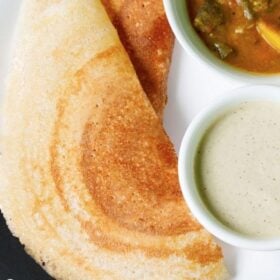
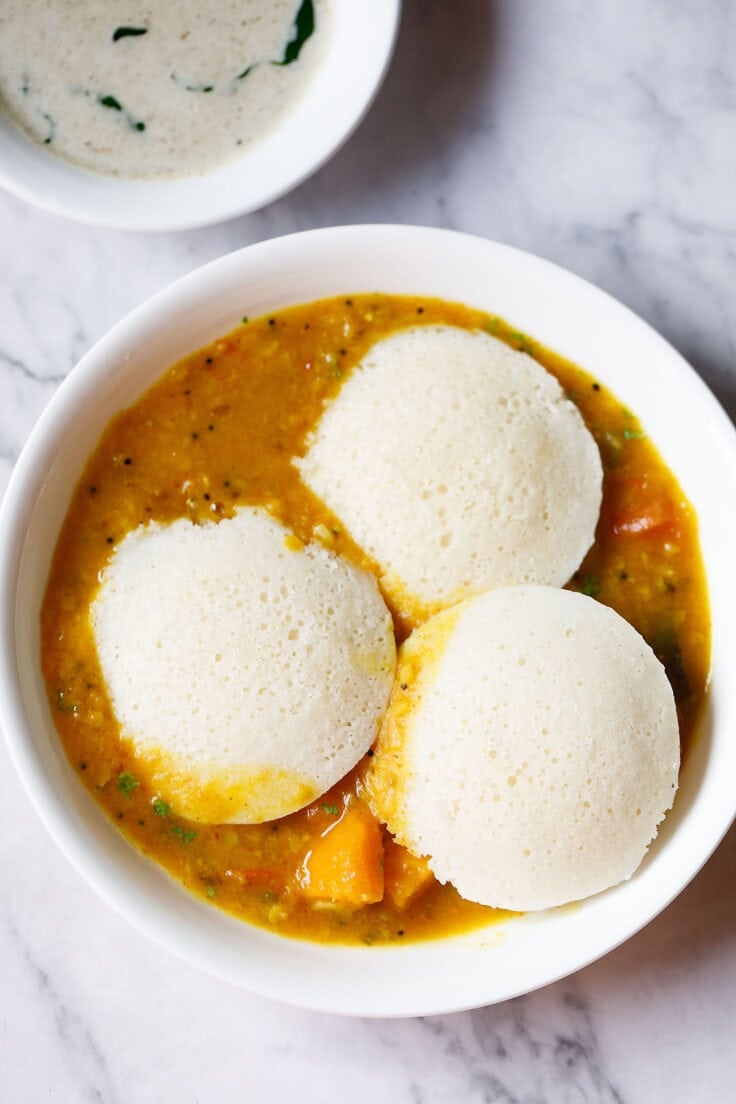
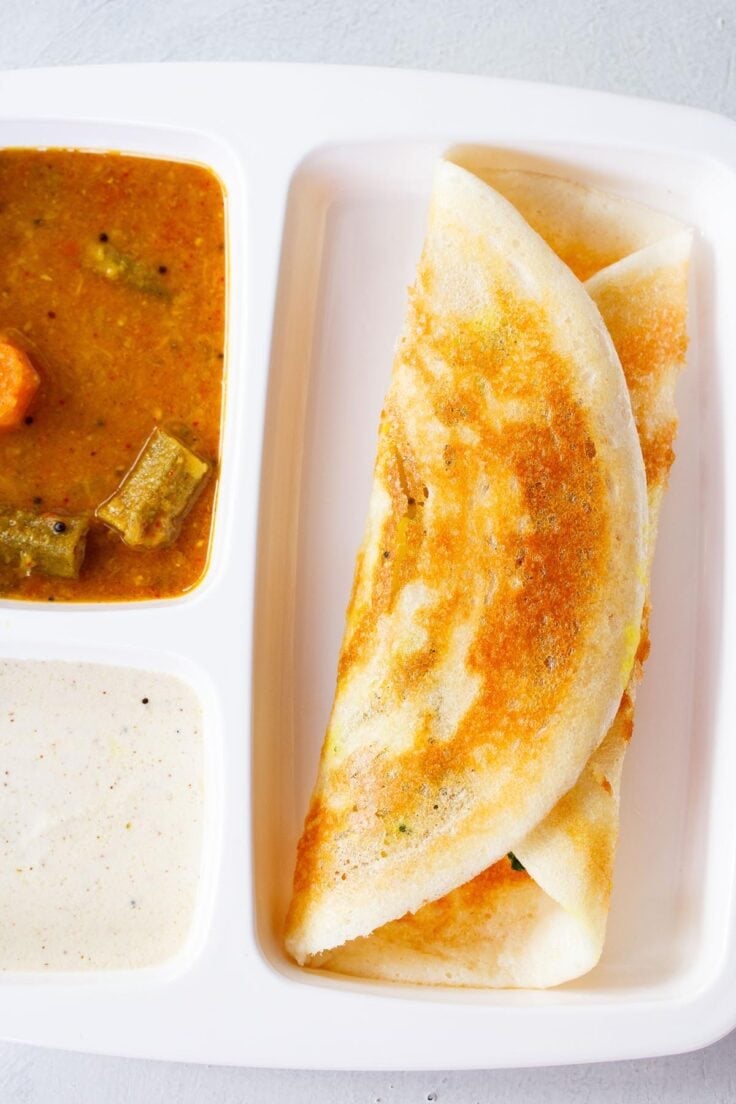
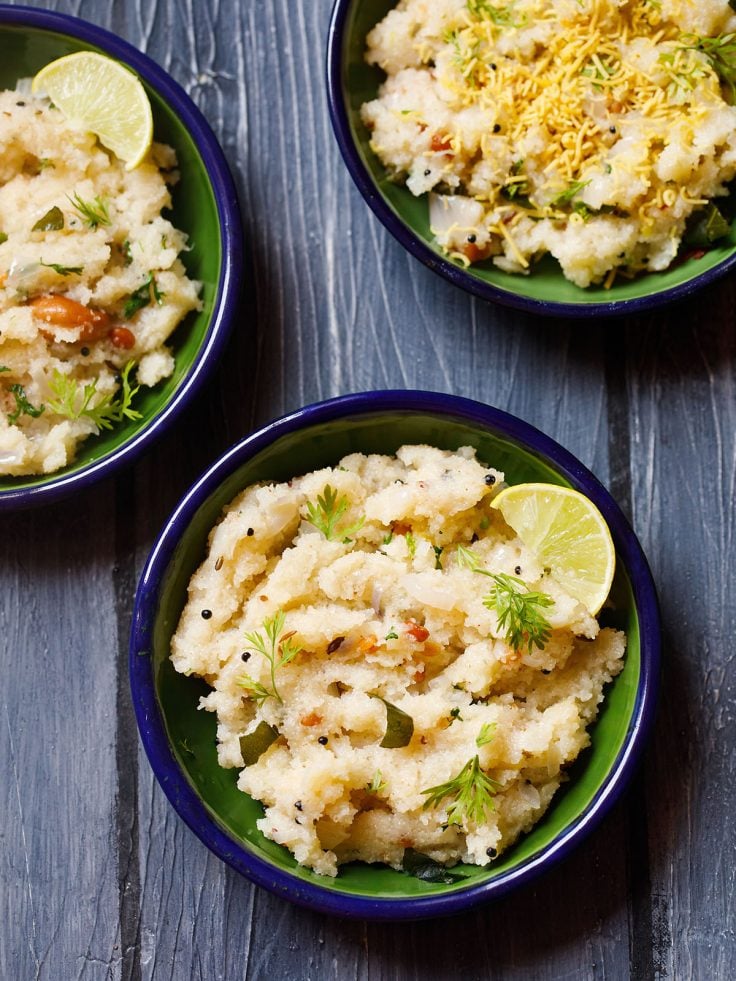
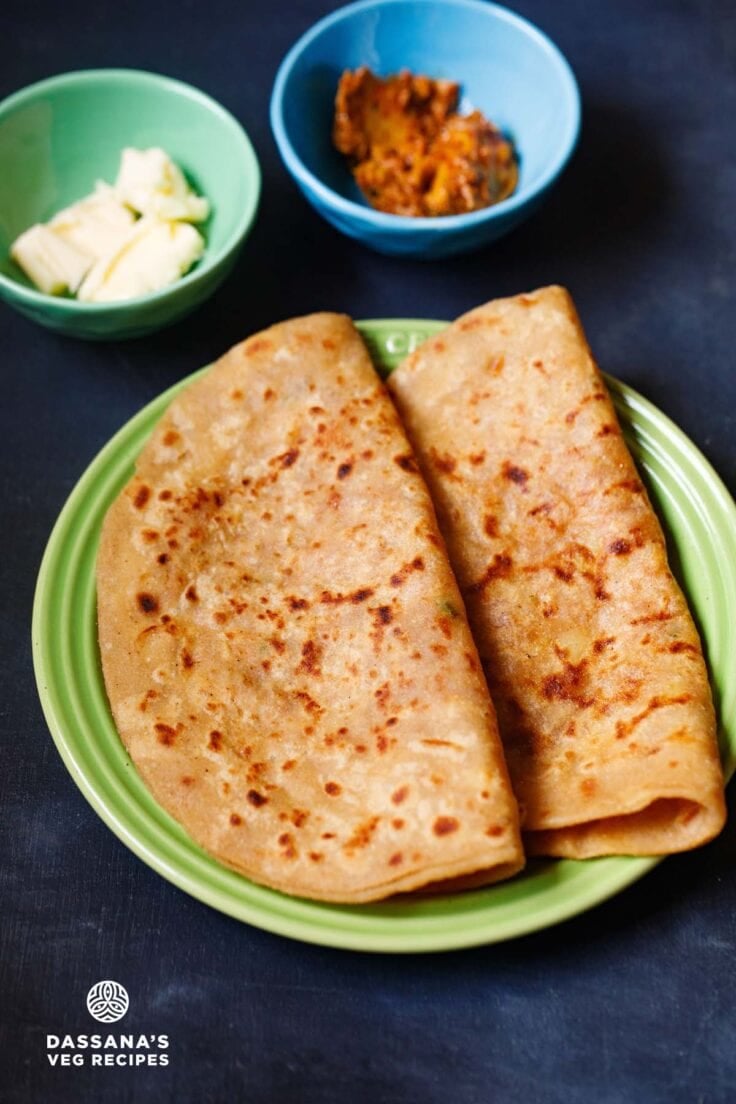
If you’re looking for a go-to recipe for dosa batter, this is the one. You can customize it as per your needs, just like I do once a while, it still results in amazingly crisp and yum dosas.
5 star
Thanks.
Hello Dassana!
Perfect batter for dosa, idli and even uttapam, (added gram flour to the finished batter)!!
One question, for how long should I soak the poha? Just add it to the rice for the whole soaking period?
Thank you!!!
Thank you. You can soak the poha with the rice or soak it separately for about 30 minutes to an hour.
Hello, thank you for these wonderful instructions! I am curious about something: I wonder how dosa batter was ground in the days before electricity? Is that something you have any knowledge of?
Also, I wonder if increasing the portion of legumes and decreasing the portion of grain would affect the fermentation?
Thank you for your thoughts!!!
Yes, in Southern India, you will find stone grinders that were traditionally used to grind the dosa batter. In some households, you will still find them. The lentils and rice were ground manually with the help of these round stone grinders.
Yes the fermentation time will reduce when you add more lentils or legumes and reduce the rice. I hope this helps and thank you.
Hello, Dassana, thank you for your reply! Are the traditional grinders like a mortar and pestle type of idea? I don’t know how to search for pictures on the internet to see what the process was like.
Also, do you think that a longer soaking time would make the beans or lentils more difficult to grind finely, due to them beginning to ferment during the soak?
Welcome! Usually there are two types to make the batter – one is not exactly like a mortar-pestle but same kind of thought is applied to it. The second one is a flat rectangular stone with a heavy thick rolling stone to grind on the flat one. If you search for idli or dosa adding these words ‘village style’ on youtube, you will get to see these traditional equipments.
Yes, could be, they make time more time to grind for the same reason you have mentioned. Avoid soaking for longer times as they ferment and get an off odour.
Once in a while I am making these for my friends, and each time I’ve gotta explain that this is not you usual pancake ) The shape is not perfect, but tastes great anyway!
Thank you. It came out well. I followed the recipe on the Idli/Dosa rice proportion 1:3 and following your instructions it turned out very well. Thank you.
Welcome and thanks for the feedback. Most welcome.
Mam pls share oats dosa recipe. Thanks.
Welcome Ash. I have already shared oats dosa recipe. Kindly click on this recipe post link Oats Dosa
Hi,
Quick question, by mistake I added some extra water while grinding rice. Batter turned out little thin. I am afraid if the batter will ferment on not. Any tips as I dont want to discard the batter. The batter is composed of 1 cup urad dal: 2 cups rice: 1 cup poha.
Please guide me through.
Thanks.
Hi Ria, add some rice flour or sooji (rava) to the batter. Use rava which is fine and not coarse. You can add it just before making the dosa also.
I can’t wait to try this! But I don’t have an Indian mixer grinder or wet grinder. Can I use a Kitchen Aid stand mixer? Thank you!
For grinding the lentils and rice, a blender like Vitamix works very well. The kitchenaid stand mixer won’t help here as the lentils and rice are ground to a batter.
Hi,
I made a batch of dosa batter and the batter has well fermented.
I have stored it in freezer.
Will the batter last good for least 2-3 weeks while in frozen?
Thanks.
Yes it will last good for 2 to 3 weeks in the freezer.
Makes very nice I have tried it but in non stick pan.d
Can sugar be put in the batter. Please let me know.
thanks neelam. sugar can be added in the batter. half to 1 teaspoon of sugar can be added.
Hello,
I don’t how I came across your blog 2 or 3 years ago. But I am so happy I did. Being a Syrian Christian, non-veg rules my household. But there are those few days we all crave for some veg recipes as we all have travelled around the country and we have our favourites. I’m no veteran in cooking, but if I could suggest your blog to my mom and she loved the recipe for a dish she already knows the recipe of, that’s some serious skill 🙂
Thank you so much for helping me with all the help you have been from the time I have referred to your recipes, I blindly suggest to all cuz each recipe is foolproof 🙂
Anju
thank you much anju. i am really glad reading your comment and feeling motivated too. comments like yours encourage and guide me to develop better recipes and present them also very well on the blog. thanks again.
all the best to you and give my regards to your mom.
Hi dassana, wanted to know the purpose of using idli rice +regular rice for making the batter,why not just idli rice?
when just idli rice is used, the dosa tend to be soft and fluffy. some proportion of regular rice helps in making the dosas crispy.
Thank you????????
Welcome Ashwini
Hei Dassana!
Thanks for sharing your recipe 🙂
I have some doubt that can i use regular rice instead of idli or pre-boiled rice and i have powderd urad dal so what quantity i should take. How to get the batter ferment easily because we are having winter(temp -5)
TIA!
welcome. you can use regular rice for dosa batter. take 1/2 cup of urad dal flour. usually i keep the pan in a warm oven or in a warm place in the kitchen. just preheat oven on a low temp for some minutes. then switch off the oven and place the batter in it. if your oven has lights then keep the lights on and keep batter inside. you can even keep batter near a heater.
Hi Dassana! Thank you for this recipe.
Can I substitute the regular rice with brown sona massori rice? I want to know if I can use brown rice+parboiled/idly rice. Thanks!
welcome neeta. you can use regular rice instead of sona masuri rice. you can use brown rice+parboiled/idly rice combination.
Superb recipe Dassana. The dosas were too good. I live in a place where the winter is currently harsh, the idea of adding poha worked. Thanks for sharing.
Welcome Rithika. Glad to know that you liked the dosas.
Hi Ms.Dassana,
Thanks for sharing the recipes…
I tried your rava idli recipe and it was amazing my employers love it.
Now I want to make this dosa. Should I keep the batter in fridge or at room temperature during fermentation process? I’m confused coz my employer told me that I keep inside the fridge and the urad dhal and rice don’t need to mix… I doubt in her suggestion coz she’s not that pro in cooking… I feel like she’s only guessing… the first time I followed her rava idli it did not turned well.unlike your recipe that I followed today..
Sooooooo yummy.
Thanks
Jen
welcome jen. for dosa batter to ferment, you have to keep it at room temperature. if you like in a hot or warm city, then the dosa batter will get fermented in 6 to 9 hours. but if the climate is cool or cold, then it takes more hours for the batter to ferment. once the batter is fermented, then you keep in the fridge. remove extra batter in a bowl and make dosas from it. remaining you keep covered in fridge. also both the urad dal batter and rice batter has to be mixed well.
Hi!
As u wrote Its possible to use raw rice, but here we have only Basmati rice from India (no Masuri or Parmal). is it possible ? I can get Jasmin rice from Thailand or what we call here “parsian rice”. which one is recommended ?
thanks!
welcome noam. don’t use jasmine rice. you can use basmati rice but try buying basmati rice which are not very long grains. this is not the best and recommended option but for your situation it is a good option.
Hi and thanks for the detailed recipe!
usually I’m (trying) to make the “restaurant style masala dosa” but now I saw this post, and the butter ingredients and steps is diff (rice types, soaking together etc).
which recipe should I use ?
Welcome Noam. You can use any dosa recipe. Both are good. The masala dosa recipe gives a more crisp texture in the dosa as compared to this plain dosa recipe.
Hi daasna, i always try your recipes and come out well.
But this time i am worried about fermentation because i stay in japan and whether is in between 20 to 25 degrees.
What can i do to ensure perfect fermentation..
Pls help
hetal, i have the issue during winters here. so i keep the batter for a long time. at times i have kept the batter for even 20 hours. also if your oven has light, then you can keep the batter in the lighted oven. or keep the batter in a warm place like near a heater. also add a bit of sugar in cold temperatures as sugar helps in fermenting and avoid adding salt. salt is best added if living in warm or hot places, as then salt does not allow the batter to get fermented too much.
Thanks Daasana… I added salt before so frementation didnt come that well but the dosa were really yummy…. This time i will add sugar and try…
Thanks a lot
welcome hetal. do try and you will see the difference.
hii mam, m big fan of ur blog…u r just amazing. i m having one confusion that whether idli batter can we use for dosa making also?
thanks mamta for your kind words. yes you can use. just add some water if required to the idli batter. so that the batter spread easily on the tawa.
Hi! Can I substitute the white sona masoori with brown sona masoori rice?
neeta, you can use brown sona masoori rice.
Hi there!
I have a question – the batter has fermented beautifully and has risen well, however, the surface has become dry. Should I skim that off or mix it into the rest of the batter really well?
This is the second time I have tried this recipe. The first time it came out really well and my family loved the dosas! Thanks for sharing these wonderful recipes with us!
Welcome Parul, mix it well. it happens at times.
My dosa batter turned out to be a little bitter, could it be because of the methre seeds? Can I skip them?
Also, the mix got double in quantity but it was very thick …so I added water
Can u tell me how can I ensure a good consistency Batter?
I soaked the dal and rice mix for around 12hrs and let it ferment for around 10hrs as well. The temperature was 32 degrees for most part of the day and later dropped for the last 2 hrs to below 20 degrees…..
the amount of methi seeds is very less and it will not contribute towards any bitterness in the batter. you can skip them also. i guess the bitterness is due to oversoaking. just 4 to 5 hours of soaking rice and dal is enough. too much soaking can ferment the water in which they are soaked. if the batter looks thick, then you can add water. grind the urad dal very well. if this is done well and the water is sufficient in the batter, then the consistency of the batter is also good.
What is the purpose of adding Poha?
how does it help?
it helps the dosa to have some softness in the texture.
Hi Dassana. I have tried many recipes from your blog. Everytime it was successful. But this batter recipe didn’t workout. I accidentally added iodised salt and it has not fermented. Was this the reason for not fermenting it? My mom used baking soda and I want to avoid using it. If I used rock salt, would it help?
sushma, iodized salt is not the main issue. could be that the urad dal was not ground well. or could be that the temperature is low. so next time keep for some more hours. rock salt always helps. so you can add it next time you make dosa batter.
Can you freeze the fermented batter? Thanks so much for the recipe. I made it, and it came out perfectly, but I want to know if I can make a bigger batch to save.
thanks zeenat for the positive review on dosa recipe. i have never freezed dosa batter. so i don’t know if the batter gives better dosas after freezing. you will need to give a try. usually i just refrigerate the batter for some days.
hi daasana… can I use the regular rice only. I don’t have the other types.. ?? will that affect the quality of the dosa??
and I have a traditional iron tawa, I make chapatti daily but i make cheelas also on that…. should I use this tawa or a non stick pan or an anodised pan?? I have all these three.
you can use regular rice. with regular rice the dosa will have a crisp texture. taste will be slightly different as parboiled rice gives a different taste. iron tawa is best for making dosa. you can season it with some oil and keep it and then use it. just heat the tawa, spread oil. wipe it and then again spread another layer of oil. switch off the flame and then keep for a day or two or overnight. while making dosas, place the tawa on stove top. wipe the oil. when the tawa become hot, spread oil. wipe this layer. spread another layer and then start preparing dosas. you can also use a non stick or anodised pan, but i feel iron tawa gives a better texture in the dosa than using a non stick and anodised pan.
Nice sada dosa recipe..n ur benne dosa is a huge hit at home..thank u fr such lovely recipies..
I just love your blog so very much!
I learned how to cook North Indian 15 years ago and then met a Southern Indian friend who’s teaching me her family recipes. So very different from the North! Both are very good.
I showed her this site and she approved! Her only tip to me was to add 1/4 t of baking soda to help with fermentation.
Thank you for sharing your lovely recipes 🙂
thanks jenny. thats so nice of your friend to teach you south indian recipes. some folks do add baking soda both in idli as well as dosa batter. so it can be added. whenever the batter does not ferment well for me (especially during winters), thats the time i add baking soda. otherwise during summers, when the batter has fermented well, i do not add baking soda. hope this helps.
Hi,pls post the recipes of masalas like pav bhaji,chole,rajma,every day subzi and dal masala.they all r available in market but honestly very poor quality and never satisfied after spending so much money.so my humble request to u to make it possible for all ur viewers.i m sure 80% of ur viewers will agree with request.
Parul
parul, i am going to add all the masala you have requested. i am sure it will be helpful to the blog readers.